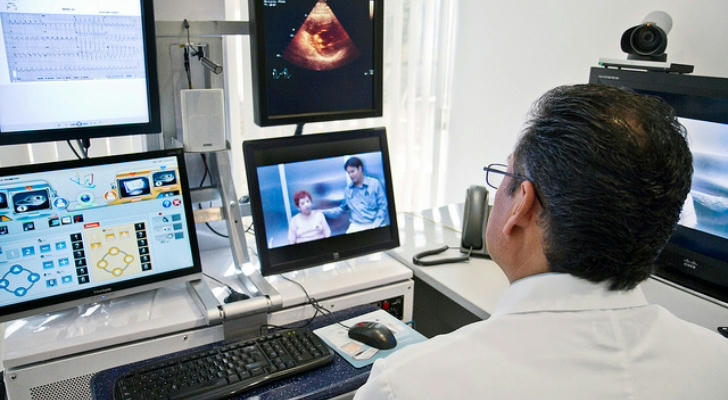Telemedicine: From Pandemic Necessity to Future Norm—2025 Trends Analysis
Imagine Sarah in rural Wyoming, struggling with chronic pain. Pre-pandemic, her 3-hour drive to the nearest specialist meant missed work and mounting costs. Today, her morning consultation happens via tablet while she sips coffee. This isn’t emergency improvisation—it’s 2025’s healthcare reality. This shift, initially driven by necessity, has now become a cornerstone of modern healthcare delivery, offering unprecedented access and convenience to patients across the globe. As healthcare systems adapt, telemedicine is not just a temporary solution but a permanent fixture in patient care strategies.

🔄 Hybrid Care: The Unstoppable New Standard
82% of patients now demand hybrid care—blending virtual convenience with critical in-person touchpoints. Cleveland Clinic’s "Click-and-Mortar" system exemplifies this:
- ✅ Tier 1: AI-powered chatbots triage 40% of initial inquiries, providing immediate responses and reducing the need for unnecessary appointments.
- ✅ Tier 2: Video consults handle routine follow-ups (e.g., medication adjustments), allowing for personalized care without the need to travel.
- ✅ Tier 3: In-person visits reserved for complex procedures, ensuring that patients receive the necessary hands-on care when required.
Why providers are racing to adapt:
📊 83% of clinicians report higher patient satisfaction scores with hybrid models. Patients appreciate the flexibility and accessibility of having multiple options for their healthcare needs.
⏱️ Appointment no-show rates dropped 57% at Johns Hopkins after implementing virtual pre-visits, indicating that patients are more likely to keep appointments that are convenient and accessible.
Moreover, hybrid care models have been shown to improve health outcomes by ensuring continuity of care. Patients who might otherwise forgo necessary follow-ups due to logistical challenges are now more likely to engage consistently with healthcare providers. This engagement is crucial for managing chronic conditions and preventing complications, ultimately reducing the burden on emergency services and hospital admissions.
🤖 AI: Telehealth’s $37 Billion Brain Upgrade
The AI healthcare market will hit $36.96 billion this year, revolutionizing remote care:
| AI Application | Real-World Impact |
|---|---|
| Predictive Diagnostics | 92% accuracy detecting cardiac anomalies (Mayo Clinic trial), enabling early intervention and better patient outcomes. |
| Administrative Bots | Saves 8.1 hours/week per clinician, allowing healthcare professionals to focus more on patient care rather than administrative tasks. |
| Chronic Care Management | 34% fewer ER visits for diabetes patients, demonstrating AI's role in proactive care management and patient education. |
AI is not only enhancing diagnostic capabilities but also personalizing patient interactions. Through advanced algorithms, AI can analyze vast amounts of data to provide tailored health recommendations, improving patient engagement and adherence to treatment plans.
Try this now: Upload wearable data to platforms like Teladoc’s AI Dashboard for instant health trajectory analysis. This integration of technology allows patients to actively participate in their health management, aligning with the growing trend of patient-centered care.

⚠️ The Reimbursement Battlefield
Medicare flexibility expires December 2025—creating a make-or-break moment. Critical gaps persist:
❗ Locum tenens telehealth reimbursements vary by 300% across states, highlighting the need for standardized policies to ensure equitable access to telehealth services nationwide.
❗ Audio-only visits face coverage cuts in 22 states, potentially limiting access for patients without video-capable devices or high-speed internet.
The reimbursement landscape is a critical factor in the sustainability of telehealth services. As policies continue to evolve, healthcare providers must navigate complex regulatory environments to secure fair compensation for telehealth services.
Action Plan:
- Audit your payer mix using tools like CoverMyMeds’ Reimbursement Forecaster to identify potential gaps and opportunities in telehealth billing.
- Join AMA’s Telehealth Coalition lobbying for HR 7621 (Permanent Parity Act), which aims to establish consistent reimbursement policies across the country.
Understanding the intricacies of telehealth reimbursement is vital for healthcare organizations to remain financially viable and continue providing high-quality care through digital platforms.
🌐 Bridging the Digital Divide: A $180B Opportunity
While telehealth booms, 28% of rural Americans still lack broadband, posing a significant barrier to accessing digital healthcare. Solutions gaining traction:
- Starlink Medical Partnerships: 1,200+ mobile clinics now offer satellite-connected "Telehealth Trailers", providing remote communities with reliable internet access and the ability to connect with healthcare providers.
- Digital Literacy Bootcamps: CVS Health’s community programs increased senior adoption by 63%, emphasizing the importance of educating older adults on using digital tools to manage their health.
- FCC’s "Connected Care" Grants: $42 million allocated for Appalachian telehealth hubs, supporting infrastructure development in underserved areas.
Addressing the digital divide is essential for ensuring equitable access to telehealth services. Investment in technology infrastructure and education can empower rural and underserved populations to fully participate in the modern healthcare ecosystem.
Programs focusing on digital literacy and access are not only improving health outcomes but also fostering a sense of empowerment and self-sufficiency among participants.
🔒 Cybersecurity: The Non-Negotiable Foundation
With 62% more health data breaches than 2023, new protocols are critical:
[Best Practice Checklist]
✅ Mandatory end-to-end encryption (HIPAA Gold Standard) to protect patient data during transmission.
✅ Biometric access controls for all patient portals, adding an extra layer of security to prevent unauthorized access.
✅ Third-party penetration testing quarterly to identify and address vulnerabilities proactively.
Case Study: After implementing Zero Trust Architecture, Kaiser Permanente reduced breach attempts by 81%. This proactive approach to cybersecurity demonstrates the importance of robust protective measures in safeguarding sensitive health information.
As telehealth adoption increases, so do the risks associated with data breaches. Healthcare organizations must prioritize cybersecurity to maintain patient trust and comply with regulatory requirements. Investing in advanced security solutions not only protects patient data but also enhances the overall reputation and reliability of healthcare providers.

🚀 Your 90-Day Telehealth Transformation Plan
Don’t become a cautionary tale—act before reimbursement shifts:
Phase 1: Infrastructure (Weeks 1-4)
- Audit EHR interoperability (Epic/Cerner integration kits) to ensure seamless data exchange between platforms.
- Train staff on hybrid scheduling tools (e.g., Zocdoc Hybrid) to optimize appointment management and patient communication.
Phase 2: Patient Onboarding (Weeks 5-8)
- Create "Tech Comfort" video tutorials to guide patients through the use of telehealth platforms, increasing their confidence and engagement.
- Launch broadband assistance program to support patients in accessing necessary technology and internet services for telehealth visits.
Phase 3: Revenue Optimization (Weeks 9-12)
- Negotiate telehealth rates with top 3 payers to secure sustainable reimbursement agreements.
- Implement RPM billing codes (99453/99454) to capture revenue for remote patient monitoring services, enhancing care for chronic conditions.
By systematically addressing infrastructure, patient engagement, and financial strategies, healthcare providers can effectively transition to a telehealth-enabled care model that meets the needs of today's patients.
⏳ Final Insight: Telemedicine isn’t replacing physical care—it’s making it smarter. Clinics delaying integration face 23% higher patient attrition (2025 MGMA data). Telehealth is not just an alternative but an essential component of a comprehensive healthcare strategy, enhancing access, efficiency, and patient satisfaction.
Your Next Step: Book a demo with certified telehealth consultants before Q3 policy deadlines. Existing platforms? Demand their 2025 compliance roadmap today. As the telehealth landscape continues to evolve, staying ahead of regulatory changes and technological advancements is crucial for maintaining competitive advantage and delivering high-quality care.
